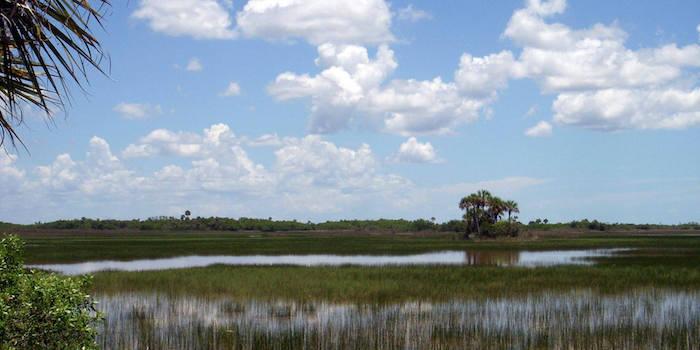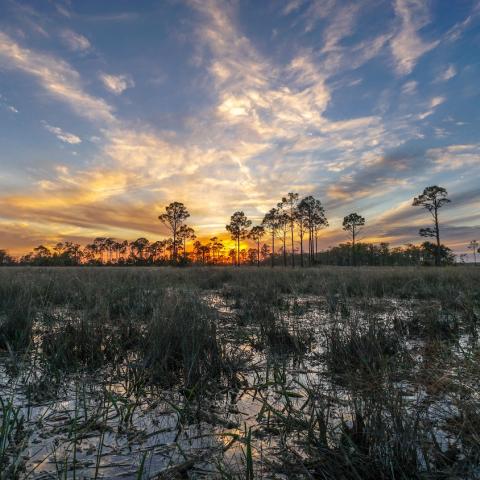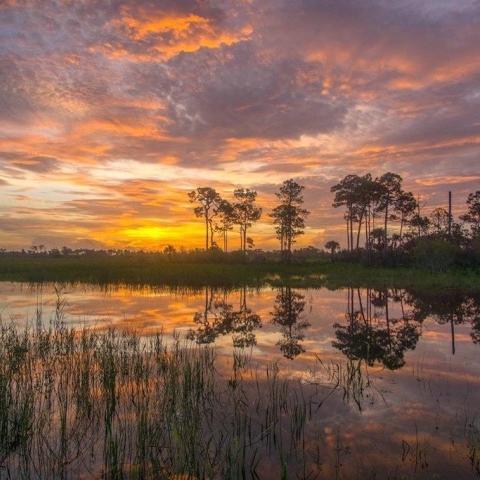
Testing for oil reserves beneath Big Cypress National Preserve could begin on March 27/NPS
Barring a last-minute court ruling, an oil exploration company could begin surveying for oil and gas reserves below Big Cypress National Preserve in Florida next Monday.
After the National Park Service approved of its exploration plans, the Burnett Oil Company set March 27 as the date it will begin the surveying process, which entails sending out 33-ton trucks to methodically crisscross the survey area while "listening" for seismic signals that could indicate oil reserves. Unless blocked by court order, the company could in theory survey about one-third of the preserve in its search for energy reserves, though the initial phase covers a much smaller area.
If the survey is carried out and points to valuable oil reserves, the company would have to submit a plan of operations for drilling. The Big Cypress staff would typically produce an environmental assessment on that plan, and it could point to the need for a more robust environmental impact study.
The survey is possible because the sub-surface mineral rights in the preserve are not owned by the Park Service. Sprawling portions are owned by the Collier Resources Co., which hired Burnett to conduct the surveys.
Big Cypress sprawls across more than 720,000 acres of Big Cypress Swamp in south Florida, protecting not only its flora and fauna but also the steady flow of freshwater that nourishes the "river of grass" that is synonymous with the Everglades. Big Cypress and Big Thicket National Preserve in Texas were the first of the National Park System's "preserves," landscapes that, while within the system, are not as protected as "national parks." Hunting and oil development are both permitted within preserves, albeit under Park Service approval and oversight.
Instead of conducting an Environmental Impact Statement on the testing, an exhaustive document that would closely examine how wildlife and vegetation might be impacted by the surveying work, Big Cypress staff wrote a less stringent Environmental Assessment to examine Burnett Oil's plans.

These vibroseis trucks can weigh 22 tons -- 44,000 pounds -- each/NPS
The National Parks Conservation Association, Natural Resources Defense Council, Conservancy for Southwest Florida, Center for Biological Diversity, Earthworks, and South Florida Wildlands Association don't flatly oppose all such energy exploration. But they do question Burnett's use of vibroseis vehicles without a more rigorous EIS. These massive trucks weigh up to 44,000 pounds. They create ground-penetrating seismic waves by exerting all their weight onto a vibrating steel pad. The shock waves are received by small instruments called "geophones," allowing the geologists to create a three-dimensional map of the underlying ground.
Last July the conservation groups filed suit to block the survey, arguing that the seismic work could adversely impact wildlife including the endangered Florida panther and pose a threat to "drinking water for many South Floridians." A federal judge, after hearing arguments on March 3 for a preliminary injunction, has yet to rule on the matter.
Whether there are "billions of dollars" worth of oil beneath Big Cypress is unknown. Florida is not among the nation's top oil-producing states. According to the U.S. Energy Information Administration, the state's total production last March was 6,000 barrels per day. North Dakota, meanwhile, reported 1.1 million barrels per day during that period, and Texas produced 3.3 million.
Currently, there are 16 production wells in Big Cypress, but not all are operational; combined they produce an estimated 30,000 barrels of oil a month, according to park staff.
In its latest court filing, Texas-based Burnett Oil cites a finding by the National Park Service on March 10 that, in its view, conditions in the preserve would be dry enough for the company to begin seismic testing as of March 22. Burnett Oil claims that it will be ready to begin preliminary scouting on March 27, and seismic testing on April 19.
“We are extremely disappointed that Burnett Oil will not wait for the court to rule on our case before starting work inside the Preserve,” said John Adornato III, NPCA's Sun Coast Regional Director. “The impact of seismic testing in the national park site has not been adequately studied, and moving forward in the middle of a court case will put Preserve resources and wildlife at risk.”
Big Cypress National Preserve was transferred to the federal government in 1974. At that time, many of the minerals (namely, oil) located beneath the preserve remained privately held. However, the federal government has the authority and responsibility to regulate the exploration and extraction of privately-owned minerals, and may limit surface access to protect the ecological integrity of the Preserve.
“This kind of development is incompatible with the mission of Big Cypress, and may permanently damage the landscape of the Preserve,” said Matt Schwartz of the South Florida Wildlands Association. "Driving enormous vehicles off-trail and over sensitive wetlands will likely to lead to severe impacts on soils, plants, hydrology, and endangered wildlife."
The seismic testing alone can impact endangered species, defoliate and flatten vegetation, alter hydrology, and compact and rut sensitive soils, among other damage it can cause, the groups argue. The Florida panther is not the only threatened or endangered (T&E) species in Big Cypress in general or the survey area specifically. Others, according to the Fish and Wildlife Service, include:
* Florida bonnetted bat, an endangered species that possibly could be using the area for roosting and foraging;
* Wood stork, an endangered species;
* Red-cockaded woodpecker, an endangered species that uses colony areas ranging up to 10 acres in size and home ranges up to 400 acres;
* Everglade snail kite, an endangered species;
* Audubon's Crested Caracara, a threatened species that might having nesting sites within the survey area;
* Eastern Indigo snake, a threatened species that could be present within the survey area, and;
* American alligator, a threatened species that might be present within the survey area.
“The Big Cypress is an essential area for many wildlife species, including the red-cockaded woodpecker, wood stork, and Florida panther,” said Amber Crooks of Conservancy of Southwest Florida. “It is also an important landscape for people as it provides important underground drinking water resources.”
“The beautiful natural landscape and precious wildlife in Big Cypress attract some 1.1 million visitors a year—so it’s not only environmentally, but economically, important to the state of Florida,” added Alison Kelly of the Natural Resources Defense Council. “The National Park Service has a duty to protect Big Cypress for the use and enjoyment of all Americans and future generations. To that end, it should have fully studied the environmental impacts of the oil company’s unprecedented seismic exploration proposal prior to allowing it.”



 Support Essential Coverage of Essential Places
Support Essential Coverage of Essential Places







Comments
My Dad, James Sewell, headed the land acquisition project to protect the Big Cypress for future generations to enjoy. This haphazard exploration project, along with the probable expansion of drilling in this area are sure to damage, if not destroy the fragile ecosystem in this area. Dad would be heartbroken... we all should be heartbroken...
Hey there James. I am working on a book concerning Big Cypress the place I was born and raised. (Ochopee). My family new your dad pretty well. They say they may have known him even in the 1960's up in the North part of the county. I needed to ask you a few questions. The oil company let my Cub Scout group back in the Big Cypress days watch them put the first test drill into the ground. Yeah, they shouldn't take oil from the ground in Florida. It's way too risky. Basically it could pollute the whole state's water. Look me up on FaceBook. My email: [email protected].